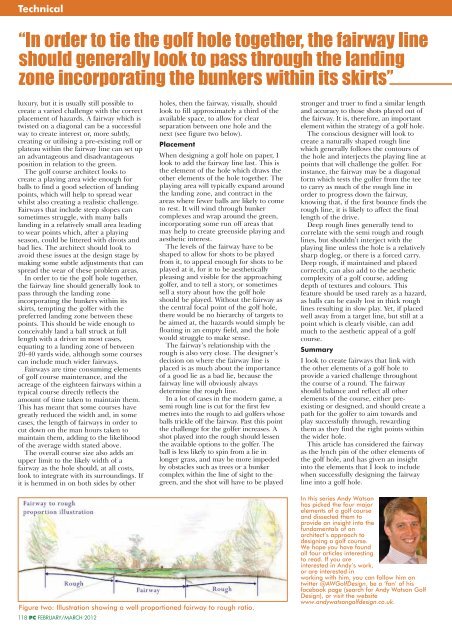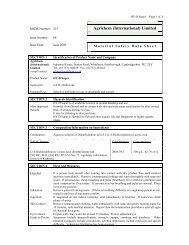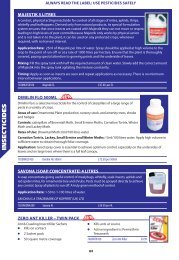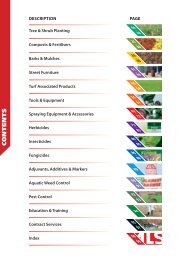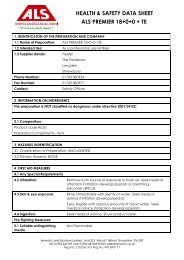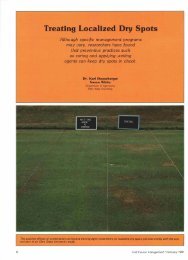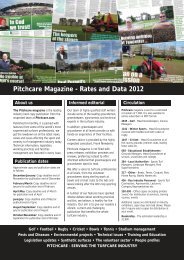these Open Championship Clubs choose to relief grind - Pitchcare
these Open Championship Clubs choose to relief grind - Pitchcare
these Open Championship Clubs choose to relief grind - Pitchcare
You also want an ePaper? Increase the reach of your titles
YUMPU automatically turns print PDFs into web optimized ePapers that Google loves.
Technical<br />
“In order <strong>to</strong> tie the golf hole <strong>to</strong>gether, the fairway line<br />
should generally look <strong>to</strong> pass through the landing<br />
zone incorporating the bunkers within its skirts”<br />
luxury, but it is usually still possible <strong>to</strong><br />
create a varied challenge with the correct<br />
placement of hazards. A fairway which is<br />
twisted on a diagonal can be a successful<br />
way <strong>to</strong> create interest or, more subtly,<br />
creating or utilising a pre-existing roll or<br />
plateau within the fairway line can set up<br />
an advantageous and disadvantageous<br />
position in relation <strong>to</strong> the green.<br />
The golf course architect looks <strong>to</strong><br />
create a playing area wide enough for<br />
balls <strong>to</strong> find a good selection of landing<br />
points, which will help <strong>to</strong> spread wear<br />
whilst also creating a realistic challenge.<br />
Fairways that include steep slopes can<br />
sometimes struggle, with many balls<br />
landing in a relatively small area leading<br />
<strong>to</strong> wear points which, after a playing<br />
season, could be littered with divots and<br />
bad lies. The architect should look <strong>to</strong><br />
avoid <strong>these</strong> issues at the design stage by<br />
making some subtle adjustments that can<br />
spread the wear of <strong>these</strong> problem areas.<br />
In order <strong>to</strong> tie the golf hole <strong>to</strong>gether,<br />
the fairway line should generally look <strong>to</strong><br />
pass through the landing zone<br />
incorporating the bunkers within its<br />
skirts, tempting the golfer with the<br />
preferred landing zone between <strong>these</strong><br />
points. This should be wide enough <strong>to</strong><br />
conceivably land a ball struck at full<br />
length with a driver in most cases,<br />
equating <strong>to</strong> a landing zone of between<br />
20-40 yards wide, although some courses<br />
can include much wider fairways.<br />
Fairways are time consuming elements<br />
of golf course maintenance, and the<br />
acreage of the eighteen fairways within a<br />
typical course directly reflects the<br />
amount of time taken <strong>to</strong> maintain them.<br />
This has meant that some courses have<br />
greatly reduced the width and, in some<br />
cases, the length of fairways in order <strong>to</strong><br />
cut down on the man hours taken <strong>to</strong><br />
maintain them, adding <strong>to</strong> the likelihood<br />
of the average width stated above.<br />
The overall course size also adds an<br />
upper limit <strong>to</strong> the likely width of a<br />
fairway as the hole should, at all costs,<br />
look <strong>to</strong> integrate with its surroundings. If<br />
it is hemmed in on both sides by other<br />
holes, then the fairway, visually, should<br />
look <strong>to</strong> fill approximately a third of the<br />
available space, <strong>to</strong> allow for clear<br />
separation between one hole and the<br />
next (see figure two below).<br />
Placement<br />
When designing a golf hole on paper, I<br />
look <strong>to</strong> add the fairway line last. This is<br />
the element of the hole which draws the<br />
other elements of the hole <strong>to</strong>gether. The<br />
playing area will typically expand around<br />
the landing zone, and contract in the<br />
areas where fewer balls are likely <strong>to</strong> come<br />
<strong>to</strong> rest. It will wind through bunker<br />
complexes and wrap around the green,<br />
incorporating some run off areas that<br />
may help <strong>to</strong> create greenside playing and<br />
aesthetic interest.<br />
The levels of the fairway have <strong>to</strong> be<br />
shaped <strong>to</strong> allow for shots <strong>to</strong> be played<br />
from it, <strong>to</strong> appeal enough for shots <strong>to</strong> be<br />
played at it, for it <strong>to</strong> be aesthetically<br />
pleasing and visible for the approaching<br />
golfer, and <strong>to</strong> tell a s<strong>to</strong>ry, or sometimes<br />
sell a s<strong>to</strong>ry about how the golf hole<br />
should be played. Without the fairway as<br />
the central focal point of the golf hole,<br />
there would be no hierarchy of targets <strong>to</strong><br />
be aimed at, the hazards would simply be<br />
floating in an empty field, and the hole<br />
would struggle <strong>to</strong> make sense.<br />
The fairway’s relationship with the<br />
rough is also very close. The designer’s<br />
decision on where the fairway line is<br />
placed is as much about the importance<br />
of a good lie as a bad lie, because the<br />
fairway line will obviously always<br />
determine the rough line.<br />
In a lot of cases in the modern game, a<br />
semi rough line is cut for the first few<br />
metres in<strong>to</strong> the rough <strong>to</strong> aid golfers whose<br />
balls trickle off the fairway. Past this point<br />
the challenge for the golfer increases. A<br />
shot played in<strong>to</strong> the rough should lessen<br />
the available options <strong>to</strong> the golfer. The<br />
ball is less likely <strong>to</strong> spin from a lie in<br />
longer grass, and may be more impeded<br />
by obstacles such as trees or a bunker<br />
complex within the line of sight <strong>to</strong> the<br />
green, and the shot will have <strong>to</strong> be played<br />
Figure two: Illustration showing a well proportioned fairway <strong>to</strong> rough ratio.<br />
118 PC FEBRUARY/MARCH 2012<br />
stronger and truer <strong>to</strong> find a similar length<br />
and accuracy <strong>to</strong> those shots played out of<br />
the fairway. It is, therefore, an important<br />
element within the strategy of a golf hole.<br />
The conscious designer will look <strong>to</strong><br />
create a naturally shaped rough line<br />
which generally follows the con<strong>to</strong>urs of<br />
the hole and interjects the playing line at<br />
points that will challenge the golfer. For<br />
instance, the fairway may be a diagonal<br />
form which tests the golfer from the tee<br />
<strong>to</strong> carry as much of the rough line in<br />
order <strong>to</strong> progress down the fairway,<br />
knowing that, if the first bounce finds the<br />
rough line, it is likely <strong>to</strong> affect the final<br />
length of the drive.<br />
Deep rough lines generally tend <strong>to</strong><br />
correlate with the semi rough and rough<br />
lines, but shouldn’t interject with the<br />
playing line unless the hole is a relatively<br />
sharp dogleg, or there is a forced carry.<br />
Deep rough, if maintained and placed<br />
correctly, can also add <strong>to</strong> the aesthetic<br />
complexity of a golf course, adding<br />
depth of textures and colours. This<br />
feature should be used rarely as a hazard,<br />
as balls can be easily lost in thick rough<br />
lines resulting in slow play. Yet, if placed<br />
well away from a target line, but still at a<br />
point which is clearly visible, can add<br />
much <strong>to</strong> the aesthetic appeal of a golf<br />
course.<br />
Summary<br />
I look <strong>to</strong> create fairways that link with<br />
the other elements of a golf hole <strong>to</strong><br />
provide a varied challenge throughout<br />
the course of a round. The fairway<br />
should balance and reflect all other<br />
elements of the course, either preexisting<br />
or designed, and should create a<br />
path for the golfer <strong>to</strong> aim <strong>to</strong>wards and<br />
play successfully through, rewarding<br />
them as they find the right points within<br />
the wider hole.<br />
This article has considered the fairway<br />
as the lynch pin of the other elements of<br />
the golf hole, and has given an insight<br />
in<strong>to</strong> the elements that I look <strong>to</strong> include<br />
when successfully designing the fairway<br />
line in<strong>to</strong> a golf hole.<br />
In this series Andy Watson<br />
has picked the four major<br />
elements of a golf course<br />
and dissected them <strong>to</strong><br />
provide an insight in<strong>to</strong> the<br />
fundamentals of an<br />
architect’s approach <strong>to</strong><br />
designing a golf course.<br />
We hope you have found<br />
all four articles interesting<br />
<strong>to</strong> read. If you are<br />
interested in Andy’s work,<br />
or are interested in<br />
working with him, you can follow him on<br />
twitter @AWGolfDesign, be a ‘fan’ of his<br />
facebook page (search for Andy Watson Golf<br />
Design), or visit the website<br />
www.andywatsongolfdesign.co.uk.


